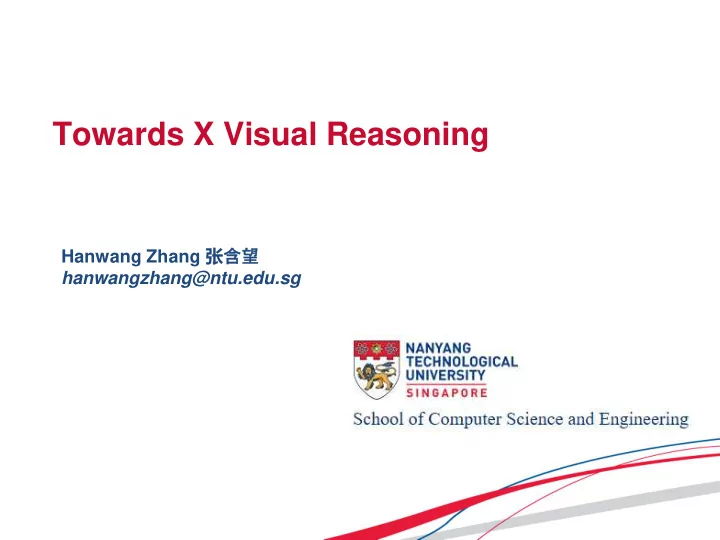

Towards X Visual Reasoning Hanwang Zhang 张 含望 hanwangzhang@ntu.edu.sg
Pattern Recognition v.s. Reasoning
Pattern Recognition v.s. Reasoning Caption: Lu et al. Neural Baby Talk. CVPR’18 VQA: Teney et al. Graph- Structured Representations for Visual Question Answering. CVPR’17 Cond. Image Generation: Jonson et al. Image Generation from Scene Graphs. CVPR’18
Reasoning: Core Problems Compositionality Learning to Reason
Three Examples Visual Relation Detection [CVPR’17, ICCV’17] Referring Expression Grounding [CVPR’18] Compositionality Learning to Reason
Three Examples Sequence-level Image Captioning [MM’18 submission] Learning to Reason
Two Future Works • Scene Dynamics • Design-free NMN for VQA
Three Examples Visual Relation Detection [CVPR’17, ICCV’17] Referring Expression Grounding [CVPR’18] Compositionality Learning to Reason
Challenges in Visual Relation Detection • Modeling <Subject, Predicate, Object> – Joint Model: direct triplet modeling • Complexity O(N 2 R) hard to scale up – Separate Model: separate objects & predicate • Complexity O(N+R) visual diversity
TransE: Translation Embedding [Bordes et al. NIPS’13] Head+ Relation ≈ Tail _has_genre WALL-E Animation Computer Anim. Comedy film Adventure film Science Fiction Fantasy Stop motion Satire Drama Connecting
Visual Translation Embedding [Zhang et al. CVPR’17, ICCV’17] • VTransE: Visual extension of TransE
VTransE Network
Evaluation: Relation Datasets • Visual Relationship Lu et al. ECCV’16 • Visual Genome Krishna et al. IJCV’16 DataSet Image Object Predicate Unique Relation/ Relation Object VRD 5,000 100 70 6,672 24.25 VG 99,658 200 100 19,237 57 Main Deficiency : Incomplete Annotation 13
Does TransE work in visual domain? • Predicate Prediction
Does TransE work in visual domain?
Demo link: cvpr.zl.io
Demo link: cvpr.zl.io
Phrase Detection: only need to detect the <subject, object> joint box Relation Detection: detect both subject and object Retrieval: given a query relation, return images VTransE were best separate models in 2017. ([Li et al. and Dai et al. CVPR’17 are (partially joint models) New state-of-the- art: Neural MOTIF (Zellers et al. CVPR’18, 27.2/30.3 R@50/R@100) Bad retrieval on VR is due to incomplete annotation 18
Two follow-up works • The key: pure visual pair model f(x 1 , x 2 ) • f(x1,x2) underpins almost every VRD • Evaluation: predicate classification • 1. Faster pairwise modeling (ICCV’17) • 2. Object- agnostic modeling (ECCV’18 submission)
Parallel Pairwise R-FCN (Zhang et al. ICCV’17) VRD R@50 VRD VG R@50 VG R@100 R@100 VTransE 44.76 44.76 62.63 62.87 PPR-FCN 47.43 47.43 64.17 64.86
Shuffle-Then-Assemble (Yang et al. 18’)
Shuffle-Then-Assemble (Yang et al. 18’)
Three Examples Visual Relation Detection [CVPR’17, ICCV’17] Referring Expression Grounding [CVPR’18] Compositionality Learning to Reason
What is grounding? Object Detection Link words (from a fixed vocab.) to visual objects O(N) R Girshick ICCV’15
What is grounding? Phrase-to-Region Link phrases to visual objects O(N) Plummer et al. ICCV’15
What is grounding? Visual Relation Detection O(N 2 ) Zhang et al. CVPR’17
What’s referring expression grounding? O(2 N )
Prior Work: Multiple Instance Learning Max-Pool [Hu et al. CVPR’17] Noisy-Or [Nagaraja et al. ECCV’16 ] O(2 N ) O(N 2 ) Bad Approximation: 1. Context z is not necessarily to be a single region 2. Log-sum directly to sum-log is too coarse, i.e., forcing every pair to be equally possible MIL Bag
Our Work: Variational Context [Zhang et al CVPR’18] Variational lower-bound: Sum-log
SGD Details z: reasoning over 2 N Deterministic function REINFORCE with baseline (Soft attention) (MC, hard sampling)
Network Details
Network Details
Grounding Accuracy The best VGG SINGLE model to date. Best ResNet Model: Licheng Yu et al. MAttNet: Modular Attention Network for Referring Expression Comprehension. CVPR’18
More effective than MIL R. Hu et al. Modeling relationships in referential expressions with compositional mod- ular networks. In CVPR , 2017
Qualitative Results A dark horse between three lighter horses
Three Examples
Neural Image Captioning GoogleNIC (Vinyals et al. 2014) Encoder ( Image CNN Vector ) Decoder ( Vector Word Seq .)
Sequence-level Image Captioning
Context in Image Captioning
Context-Aware Visual Policy Network
Context-Aware Policy Network
Context-Aware Policy Network
MS-COCO Leaderboard We are SINGLE model.
Compare with Academic Peers
Detail Comparison with Up-Down P. Anderson et al. Bottom-up and top-down attention for image captioning and VQA. In CVPR’18
Visual Reasoning: A Desired Pipeline • Configurable NN for various reasoning applications : Visual Configurable knowledge Task Graph Network Captioning, VQA, and Visual Dialogue
Visual Reasoning: Future Directions • Compositionality – Good SG generation – Robust SG representation – Task-specific SG generation • Learning to reason – Task-specific network – Good policy-gradient RL for large SG
Hard-design X Module Network • Q Program not X • Module X but hard- design • CLEVER hacker • Poor generalization to COCO-VQA Jonson et al. ICCV’17 Hu et al. ICCV’17 Mascharka et al. CVPR’18
Design-Free Module Network C C A A A S A A A S A Choi et al. Learning to compose task- specific tree structures. AAAI’17
Recommend
More recommend